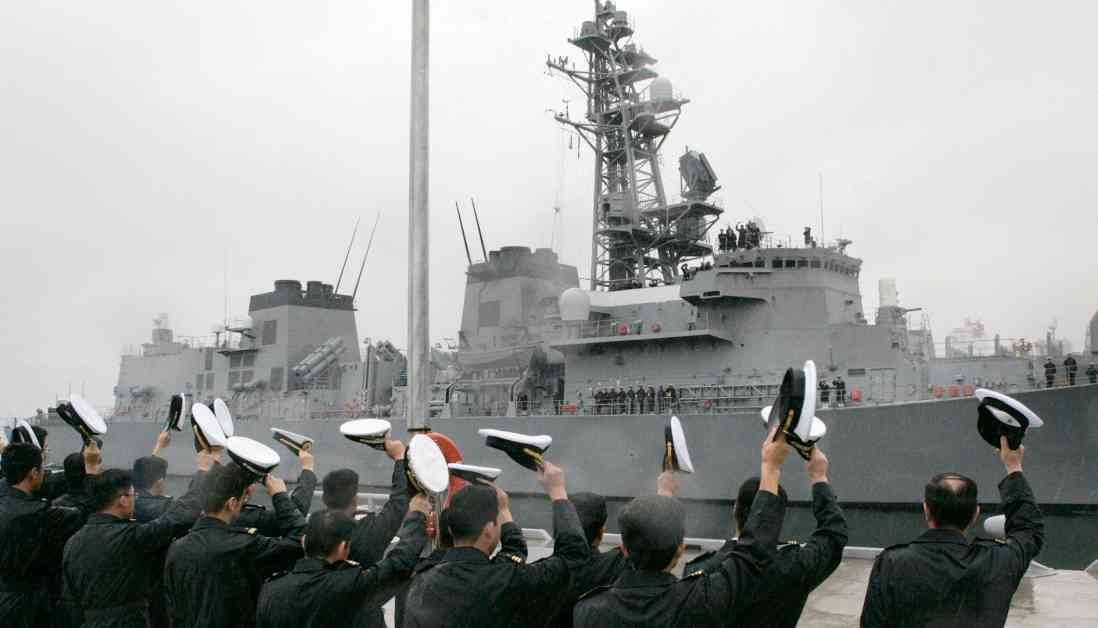Japan’s Historic Move: Deploying Warship Through Taiwan Strait
In a significant and historic move, Japan has deployed a warship through the Taiwan Strait for the first time. The Sazanami, a Japanese destroyer, sailed south through the 180-kilometre waterway, accompanied by ships from Australia and New Zealand. This maneuver comes amidst escalating military activities by China in the region, raising concerns about security and stability in East Asia.
The Sazanami’s transit through the Taiwan Strait was a carefully coordinated operation that saw the vessel enter the strait from the East China Sea on a Wednesday morning. The ship spent over 10 hours sailing south to complete the passage, marking a milestone in Japan’s military strategy in response to China’s growing assertiveness in the region. The joint naval exercise with Australia and New Zealand ahead of planned drills in the disputed South China Sea underscores the strategic importance of the Taiwan Strait as a key maritime route in East Asia.
Japanese media outlets, including public broadcaster NHK and the Yomiuri Shimbun newspaper, reported on the Sazanami’s passage through the Taiwan Strait. The deployment of the warship represents a proactive response to China’s increasing military presence near Japan’s territorial waters. While the Japanese government has refrained from commenting on the specifics of the operation, the move signals Tokyo’s commitment to safeguarding its national security interests in the face of growing regional challenges.
The transit through the Taiwan Strait comes on the heels of a series of provocative actions by China, including the passage of the Liaoning aircraft carrier between two Japanese islands near Taiwan. This incursion into Japanese territorial waters prompted a strong reaction from Tokyo, with officials denouncing the incident as “totally unacceptable.” The escalation of tensions between Japan and China underscores the need for increased vigilance and cooperation among regional partners to maintain peace and stability in the Asia-Pacific region.
Subheadings:
1. Regional Dynamics: Japan’s Response to China’s Military Activities
2. Strategic Implications: Significance of the Taiwan Strait Transit
3. International Reactions: Global Concerns Over China’s Military Build-up
The Sazanami’s transit through the Taiwan Strait comes at a time of heightened security concerns in East Asia, as major powers jockey for influence and control in the region. Japan’s decision to deploy a warship through the strait reflects its strategic calculus in response to China’s assertive maritime posture. With China’s increasing military activities near Japan’s territorial waters, Tokyo is taking proactive measures to protect its national security interests and uphold the rules-based international order.
The significance of the Taiwan Strait transit extends beyond the immediate military implications, highlighting the strategic importance of the waterway as a key maritime route in East Asia. As a critical chokepoint connecting the East China Sea and the South China Sea, the Taiwan Strait serves as a gateway for trade, commerce, and military operations in the region. Japan’s deployment of the Sazanami through the strait underscores the country’s commitment to upholding freedom of navigation and ensuring the security of vital sea lanes in the Indo-Pacific region.
The international community has been closely monitoring developments in the Taiwan Strait, with global concerns mounting over China’s military build-up and assertive behavior. The United States and its allies have conducted regular patrols through the strait to reinforce its status as an international waterway, challenging China’s excessive maritime claims. Recent incidents, including China’s test launch of an intercontinental ballistic missile into the Pacific Ocean, have raised alarm bells among regional powers, prompting calls for greater cooperation and coordination to address shared security challenges.
As tensions continue to simmer in the region, the Quad grouping of Australia, India, Japan, and the United States has expanded joint security steps in Asia’s waters to counter China’s growing influence and assertiveness. The Quad’s efforts to enhance maritime security and promote a rules-based order in the region underscore the shared concerns among like-minded countries about China’s destabilizing actions. By strengthening their cooperation and coordination, the Quad countries aim to deter aggression and maintain peace and stability in the Indo-Pacific region.
In conclusion, Japan’s deployment of a warship through the Taiwan Strait marks a significant milestone in the country’s efforts to respond to China’s military activities in the region. The transit of the Sazanami underscores Tokyo’s commitment to safeguarding its national security interests and upholding the rules-based international order. As regional tensions continue to escalate, the international community must remain vigilant and proactive in addressing emerging security challenges in the Indo-Pacific region.



























